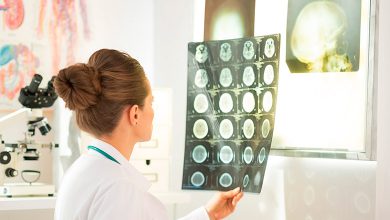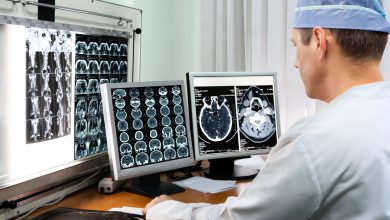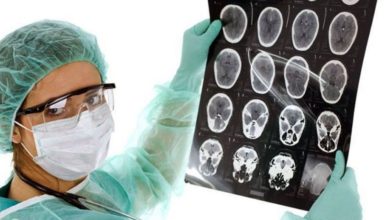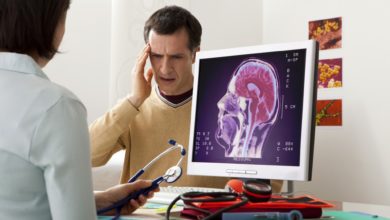Headaches due to brain tumor
The content of the article
State of a person with illness
A brain tumor is an oncological disease, very dangerous and insidious. It is this disease that most often leads to death. At the initial stage of the disease, headaches are very similar to the symptoms of migraine. Therefore, this does not alarm people, and they refrain from going to a specialist. But there are still symptoms that distinguish a growing tumor.
Leading experts in this field describe how a headache with a brain tumor hurts. These are the accompanying symptoms:
- When the tumor increases in size. It compresses the nerve endings and this is accompanied by pain. At the onset of the disease, headaches appear and disappear throughout the day. But with development, these sensations become permanent.
- In old age, people with this disease have mental disorders and are often unaware of what is happening around them.
Main symptoms
It is imperative to contact a medical facility if the following symptoms are noted:
- A person sleeps for a long time, and after waking up he cannot concentrate and realize what is happening around him.
- The whole day is accompanied by a throbbing headache.
- Headaches can appear with a sudden change in body position.
- Later stages are accompanied by double vision and numbness in the arms and legs.
- Unreasonable attacks of nausea and even vomiting occur.
- Speech begins to become confused.
- Movements become uncontrollable, speech is incoherent. The person may lose consciousness.
- Headache due to brain tumor does not go away. Painkillers do not help, and the pain intensifies when coughing and blowing the nose.
Diagnostics
All these symptoms should alert you, and they are a reason to urgently contact the clinic to receive a referral for an MRI . A computed tomography scan will allow you to exclude or confirm suspicions of a cancerous tumor. There should be no self-medication. Only an experienced doctor, after conducting a number of examinations and tests, is able to make the correct diagnosis. The patient, studying his condition, must follow all the doctor’s recommendations and prescriptions in order to prevent further development of the tumor process.
For example, the frontal part of the brain regulates people's ability to behave differently in life situations, such as the ability to walk or stand. In a word, for coordination of movements and the ability to think. If the tumor affects this area, the person's perception and personality may completely change. If symptoms such as loss of coordination, loss of taste and smell appear, mood changes sharply and headaches are tormented, you should immediately contact a neurologist.
Throbbing pain in the temples, epileptic seizures, strange visions and unreasonable fear, as well as loss of taste and vision are signs of the development of a malignant tumor in the temporal region of the brain. When it grows, it puts pressure on the optic nerves and can lead to blindness.
When the tumor affects the parietal region, the largest part of the brain, headaches intensify and all other symptoms may become more intense. A tumor in the lower part can lead to loss of sensation in the head and to cramps, in which the muscles of the face, arms and legs twitch. A tumor in the superior parietal lobe leads to muscle atrophy; with epilepsy, the part of the face on the side opposite to the tumor begins to twitch. If a tumor is allowed to develop, it can lead to a tragic end.
How to distinguish tumor pain from other types of pain
The nature of headaches with brain tumors differs from other types of pain. To distinguish cancer pain from other diseases, you need to know the symptoms of these diseases.
- For example, migraines have very similar symptoms to headaches associated with brain cancer. The pain is severe, paroxysmal, and can last up to several days. Nausea and photophobia may also occur.
- Many people know firsthand what kind of headaches a person experiences from tension. These are paroxysmal pains that appear either in the frontal part or the occipital part. They can be long or very short, but have a strong effect on mood, causing depression and weakness.
- With hypertension, the pain is short, moderate in nature, localized in the occipital or parietal region. As pressure increases, they increase and can lead to dizziness, nausea and weakness.
- Paroxysmal cluster pains are very strong. As a rule, they are felt in the area of the nose, eyes and eyebrows. They are accompanied by watery eyes and sinus congestion on one side of the nose. The pain may recur periodically.
- Cervicogenic pain is distinguished by the fact that it is accompanied by tinnitus and numbness of the neck muscles. These are paroxysmal pains on both sides of the head that are paroxysmal in nature.
Seeking medical help
These include:
- constant pain in the head, varying in location and intensity;
- unexpected pain in all parts of the body;
- migraine that does not go away after three days.
If a headache occurs, you need to contact a neurologist, who diagnoses and identifies the causes of these pains. The neurologist checks reflexes, hearing, coordination of movements, and tactile sensitivity. If necessary, he may prescribe an x-ray to identify tissue calcification that forms in the presence of tumor processes.
Electroencephalography is necessary to identify any abnormalities in the functioning of the brain.
Rheoencephalography is intended for diagnosing cerebral vessels. Thermography shows the temperature in different areas of the head, identifying the cause of pain. MRI or magnetic resonance examination, tomography is performed to determine whether there is a tumor, to determine its size and location. You can find out the cause of the tumor. If the examination reveals the presence of a neoplasm, the patient is sent to the neurosurgery department for further examination and treatment.
Treatment
As for treatment, the only way to get rid of a brain tumor is through surgery. Having previously determined the size of the tumor and its location, the surgeon removes it completely. As an alternative, radiosurgery can be used - a completely painless method.
It happens that the tumor cannot be removed surgically, and then radiation therapy is used, which “kills” the cancer cells that contribute to the development of the disease.
There is another method - chemotherapy . This is a very effective drug treatment for malignant brain tumors. Medicines are administered intravenously and, once they enter the bloodstream, they destroy all foci of cancer.
As additional therapy, the doctor prescribes painkillers, vitamin preparations, and medications to relieve swelling.
In addition, the doctor prescribes various physical procedures, taking into account the individual characteristics and development of the patient’s disease. These include:
- Inductothermy. This is the effect on the affected area of a magnetic field of high frequency wave oscillations.
- Phonophoresis and ultrasound therapy. The effect of ultrasonic waves on the patient's body.
- Laser therapy. The effect of laser beams on the human body, as a result of which metabolism is normalized, promoting rapid healing and regeneration of cells in areas of affected tissue.
- Electrical stimulation. To stimulate muscle tissue and the nervous system, current pulses are sent to specific points.
- Electrophoresis. In order for medications to be absorbed by the body faster, they are administered under the influence of current.
Cancer Prevention
As a preventative measure, doctors recommend not to overuse salt. If a tumor has already formed, then you should completely avoid beans, peas, beans, and all fermented milk products. If headaches occur frequently due to brain cancer, then a certain regimen should be developed. Rest more often, try to talk less. Massage and warm foot baths will help.
Treatment with folk remedies in such cases is undesirable, but as a preventative , taking herbal remedies is recommended. The most famous in the fight against the formation of cancer cells are chaga, lemon balm, hemlock, peppermint, oregano, clover, and horsetail. But self-medication is impractical and dangerous. Therefore, it is recommended to contact experienced specialists with all questions. The key to success in treating such a dangerous disease as cancer is timely consultation with a doctor.
Based on the headache caused by brain cancer, a specialist can determine the severity of the disease. Bursting, dull pain in the head occurs in half of sick people. Therefore, headache is considered the most common symptom of the disease. Some patients do not experience prolonged headaches. This also happens if the tumor is small.
Pain begins to appear when the tumor begins to grow. And above all, they are distinguished by their consistency. Medicines do not help, and after a night's sleep the headache begins to hurt even more. This occurs due to the accumulation of fluid in the cavities of the brain, it stagnates and puts pressure on the tumor. By how it hurts you can understand whether the pain is a sign of a tumor and where it is located. But even all the signs that are characteristic of headaches due to neoplasms are not sufficient grounds for diagnosing brain cancer. The head can also hurt due to infectious diseases.
Unfortunately, brain cancer is an unpredictable disease, so you should listen to your body. If the first of the above symptoms appear, such as frequent headaches, you should immediately seek advice from specialists.
Please rate the article:





